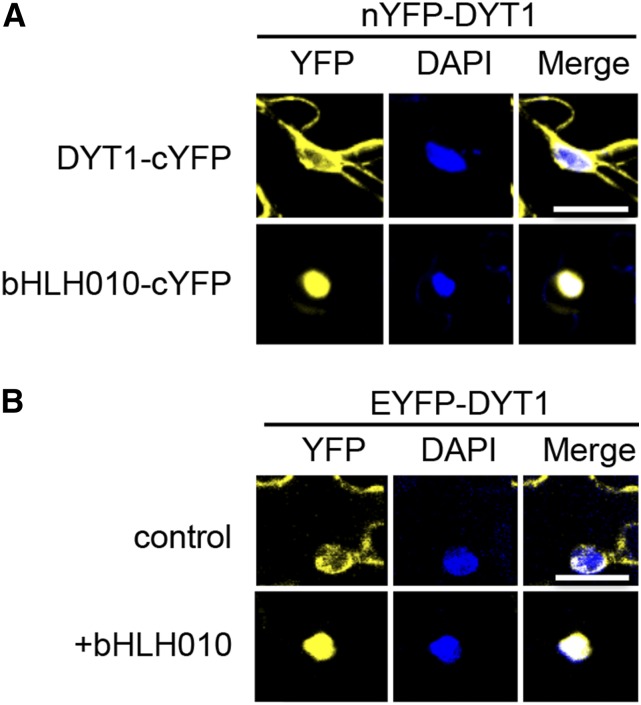Stamen primordia transform into slender filaments bearing pollen-laden anthers in a series of well-defined developmental steps (Goldberg et al., 1993; Scott et al., 2004). During anther stages 1-7, anther morphology is established, cell specification and differentiation occur, and microspore mother cells undergo meiosis (Sanders et al., 1999). At anther stages 8-14, pollen grains differentiate, filaments extend (raising anthers to optimal heights), and anthers dehisce, releasing their masses of genome dispersal units.
The basic helix-loop-helix (bHLH) transcription factor DYSFUNCTIONAL TAPETUM1 (DYT1), which is regarded as a gatekeeper transcription factor in tapetal development in Arabidopsis thaliana (Zhang et al., 2006; Gu et al., 2014), regulates ∼1000 anther-expressed genes (Feng et al., 2012), around a quarter of which are thought to be affected by feed-forward regulatory loops between DYT1 and three downstream bHLH transcription factors (bHLH010, bHLH089, and bHLH091; Zhu et al., 2015).
Now, Cui et al. (2016) have examined the mechanism by which DYT1 operates during anther development. Using an enhanced YFP (EYFP)-DYT1 fusion, the authors showed that the subcellular distribution of DYT1 is temporally regulated in tapetal cells; DYT1 occurs in both the cytoplasm and nucleus at anther stage 5, but only in the nucleus at anther stages 6 and 7. A yeast two-hybrid screen using DYT1 as bait detected clones encoding 143 candidate DYT1-interacting proteins. Bimolecular fluorescence complementation (BiFC) analysis coupled with fluorescence microscopy analysis showed that DYT1 forms heterodimers with several of these candidates (including bHLH010, bHLH089, and bHLH091) specifically in the nucleus, whereas DYT1 homodimers occur mainly in the cytoplasm (see figure). Thus, heterodimer formation appears to direct the stage-specific distribution of DYT1.
bHLH010 promotes the nuclear localization of DYT1 in a transient expression system. (A) BiFC analysis showing the distribution of DYT1 homodimer (upper panels) or DYT1-bHLH010 heterodimer in transgenic tobacco leaves. (B) The distribution of EYFP-DYT1 in transgenic tobacco leaves in the control (upper panels) or bHLH010 (lower panels) background. DAPI, 4′,6-diamidino-2-phenylindole nuclear stain. Bars = 20 μm. (Adapted from Cui et al. [2016], Figures 1D and 1F.)
Secondary structure analysis of the C-terminal region of DYT1 revealed a predicted ββαββα fold, which the authors named the BIF (bHLH protein interaction and function) domain. Further investigation showed that this domain is conserved in a subset of the large bHLH family, including the DYT1 interactors, and is required for DYT1 dimerization, nuclear localization, and transcriptional activation activity. Even though chimeric proteins in which the BIF domain of DYT1 was replaced with that of bHLH010 localized to the nucleus, they failed to rescue the phenotype of a dyt1 null mutant, indicating that the BIF domains of different bHLH proteins are functionally distinct.
These findings suggest that a series of bHLH factors downstream of DYT1 enhance DYT1 activity by promoting its localization to the nucleus, where it activates the expression of the myriad of genes required for anther development and further that the nuclear localization of DYT1 depends on its BIF domain. Thus, this work reveals a positive feedback regulatory loop in the complex transcriptional network governing anther development.
Footnotes
Articles can be viewed without a subscription.
References
- Cui J., You C., Zhu E., Huang Q., Ma H., Chang F. (2016). Feedback regulation of DYT1 by interactions with downstream bHLH factors promotes DYT1 nuclear localization and anther development. Plant Cell 28: 1078–1093. [DOI] [PMC free article] [PubMed] [Google Scholar]
- Feng B., Lu D., Ma X., Peng Y., Sun Y., Ning G., Ma H. (2012). Regulation of the Arabidopsis anther transcriptome by DYT1 for pollen development. Plant J. 72: 612–624. [DOI] [PubMed] [Google Scholar]
- Goldberg R.B., Beals T.P., Sanders P.M. (1993). Anther development: basic principles and practical applications. Plant Cell 5: 1217–1229. [DOI] [PMC free article] [PubMed] [Google Scholar]
- Gu J.N., Zhu J., Yu Y., Teng X.D., Lou Y., Xu X.F., Liu J.L., Yang Z.N. (2014). DYT1 directly regulates the expression of TDF1 for tapetum development and pollen wall formation in Arabidopsis. Plant J. 80: 1005–1013. [DOI] [PubMed] [Google Scholar]
- Sanders P.M., Bui A.Q., Weterings K., McIntire K.N., Hsu Y.-C., Lee P.Y., Truong M.T., Beals T.P., Goldberg R.B. (1999). Anther developmental defects in Arabidopsis thaliana male-sterile mutants. Sex. Plant Reprod. 11: 297–322. [Google Scholar]
- Scott R.J., Spielman M., Dickinson H.G. (2004). Stamen structure and function. Plant Cell 16 (suppl.): S46–S60. [DOI] [PMC free article] [PubMed] [Google Scholar]
- Zhang W., Sun Y., Timofejeva L., Chen C., Grossniklaus U., Ma H. (2006). Control of Arabidopsistapetum development by DYSFUNCTIONAL TAPETUM 1 (DYT1) encoding a putative bHLH transcription factor. Development 133: 3085–3095. [DOI] [PubMed] [Google Scholar]
- Zhu E., You C., Wang S., Cui J., Niu B., Wang Y., Qi J., Ma H., Chang F. (2015). The DYT1-interacting proteins bHLH010, bHLH089 and bHLH091 are redundantly required for Arabidopsis anther development and transcriptome. Plant J. 83: 976–990. [DOI] [PubMed] [Google Scholar]



